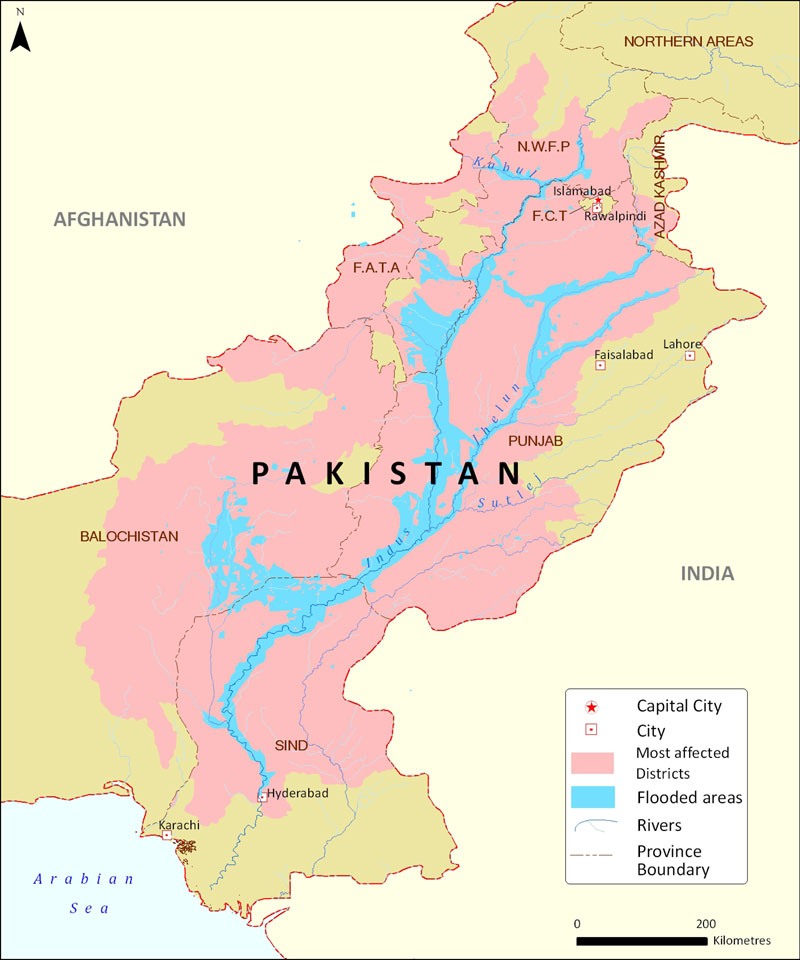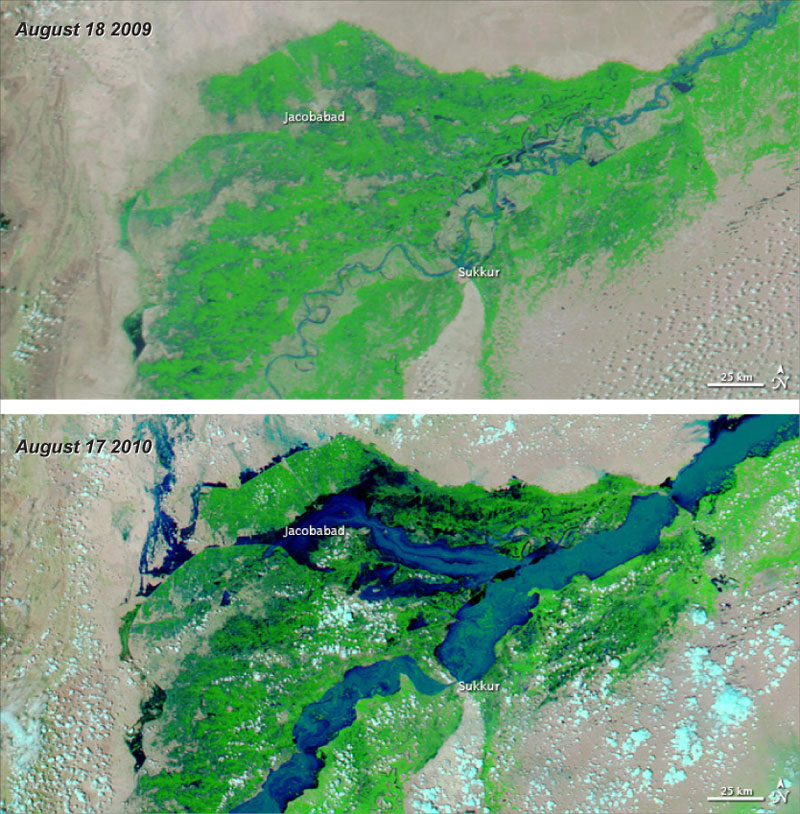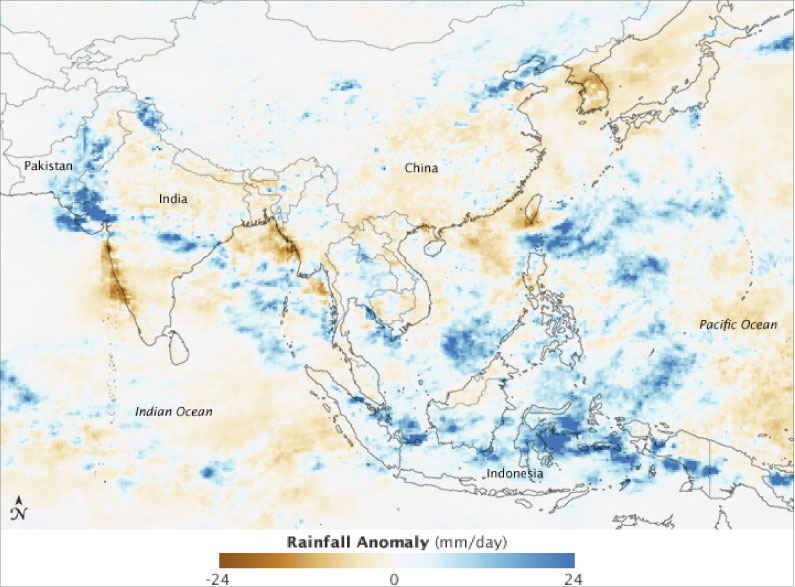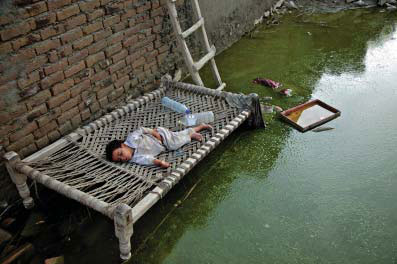|
Having trouble reading this email? Download the PDF.

Thematic Focus: Disasters and Conflicts, and Environmental Governance
Pakistan's Flood of the Century is a Global Disaster
Why is this issue important?
Northwestern Pakistan experienced its worst flooding in a century in late-July and early-August 2010.
Unusually heavy monsoon rains led the Indus River to inundate areas far beyond its banks affecting the
densely populated Punjab and other regions. More than 1 600 people have died, 2 million are homeless,
and from 15 to 20 million people are affected (UN2010). The floodwaters destroyed large parts of the
infrastructure and crops in Pakistan's breadbasket.
The issue is a significant environmental disaster, since the area is primarily based on an agrarian economy.
Some 6 879 655 ha of agricultural land have been submerged. In the Punjab alone, almost 404 685 ha of
cotton-growing land was affected. The flood-affected lands could lose their crop and livestock producing
capacity, with severe long-term impacts on both the environment and livelihoods. In addition, the fl oods
will force more people to move to already crowded urban areas.

Figure 1: The districts affected by the Indus flooding. The flood wave initiated by the heavy rains can be tracked by river gauges
as it perpetuates downstream (Source: OCHA 2010).

Figure 2: Satellite imagery (MODIS Terra) showing the extent of the flooded area in the worst affected area around the city of
Sukkur (bottom, acquired 17 August 2010) in comparison to the river water one year earlier (top, acquired 18 August 2009). Note
that clouds appear as turquoise-white (Source: NASA 2010).
What are the findings and implications?
The unusually high monsoon rains responsible for the flooding are part of an anomalous weather pattern across Asia causing fl oods and landslides in China
and North Korea and heavy rains in Indonesia. Figure 3 shows the difference in rainfall from the regional average, illustrating the enhanced Asian Monsoon
originating over the Indian Ocean. High summer temperatures on the Eurasian continent that suck in colder, moist air from the ocean, fuel the monsoon. Not surprisingly, the heavy rains coincide with a heat
wave in Russia.
By mid-August, 160 000 km2 of land was inundated, an area larger than England, and the number of people
needing shelter, food and emergency care exceeded the combined numbers affected by the Indian Ocean
tsunami (2004), the Kashmir earthquake (2005), Cyclone Nargis (2008), and the Haiti earthquake (2010) (UN 2010).

Figure 3: Rainfall patterns in Southeast Asia showing the rates of divergence from the average rates in the period
1-9 August 2010. Pakistan and Indonesia experienced especially high rainfall rates over the week (Source: NASA 2010).

A child sleeps on a bed surrounded by floodwater in his home in Khwas Koorona Village, Pakistan. An
estimated 2.5 million of the province’s 3.5 million residents have been affected by the disaster. (Source:
UNICEF 2010 via Flickr)
In 2009, the Food and Agriculture Organization of the United Nations (FAO), the World Food Programme (WFP), and the
National Disaster Management Authority (NDMA) conducted a pilot project to strengthen response to riverine fl oods
and hill torrents in the Rajanpur (Punjab) (FAO 2009). This newest disaster, however, overwhelmed domestic, NGO and
UN response capacities. A lesson learned from the disaster is that although such events are rare and unpredictable,
there is a need for renewed and up-scaled disaster preparedness, especially in light of the potential impacts of
climate change on flooding patterns.
References
FAO. (2009). FAO Representation – Pakistan. Montly Newsletter, Issue 2, February 2009. http://un.org.pk/ (Accessed on 20 August 2010)
NASA .(2010). All images for Flooding in Pakistan : Natural Hazards. Available at: http://earthobservatory.nasa.gov/ (Accessed on 12 August 2010).
OCHA. (2010). Pakistan: Situation Overview By Province - 20 August 2010. http://www.reliefweb.int/ (Accessed on August 23, 2010).
UN. (2010). General Assembly calls for strengthened emergency relief to meet Pakistan's urgent needs after massive destruction caused by
unprecedented, devastating floods. UN sixty-fourth General Assembly, 19th August 2010. http://www.un.org/ (Accessed on August 22, 2010)
Information is regularly scanned, screened, filtered, carefully edited, and published for educational purposes. UNEP does not accept any liability
or responsibility for the accuracy, completeness, or any other quality of information and data published or linked to the site. Please read our
privacy policy and
disclaimer for further information.
|









